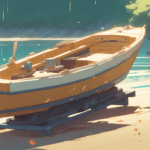Are you fed up with high trailer prices? Want to take control of your boat’s transport? You can make a custom trailer that fits your boat perfectly and save a lot of money.
Building a DIY boat trailer is more than a weekend project. It’s a chance to make a trailer that’s both practical and personal. Small boats, from 10 to 13 feet, can greatly benefit from a trailer made just for them.
Creating your own trailer needs careful planning and some technical know-how. This guide will help you make a strong, reliable trailer that meets your boating needs.
Key Takeaways – How to Build a Boat Trailer
- DIY boat trailer construction can save significant money
- Custom trailers provide better boat-specific support
- Basic welding and metalworking skills are essential
- Proper materials selection is key for trailer durability
- Understanding trailer design ensures safety and performance

Understanding the Basics of Boat Trailers
Boat trailers are key for safely moving watercraft on land. They’re vital for both weekend anglers and serious boaters. Knowing about boat trailer materials and how to assemble them greatly improves your transport experience.
Boat trailers are essential in water sports and marine transport. They help boat owners easily move their vessels. This includes going between water bodies, storage spots, and repair shops safely.
Purpose and Importance of a Boat Trailer
A boat trailer does more than just move your boat. It protects your investment by providing a stable platform during transportation. The right trailer ensures:
- Safe transportation of boats
- Protection from road damage
- Easy launching and retrieval
- Secure storage when not in use
Types of Boat Trailers
Different boats need specific trailers. The main types are:
- Bunk Trailers: Most common, using padded supports to cradle the boat
- Roller Trailers: Featuring rollers for easier boat loading
“Choosing the right trailer type is critical for boat safety and transport efficiency.”
Key Components of a Boat Trailer
Knowing about boat trailer materials ensures a strong build. Important parts include:
- Frame (usually steel or aluminum)
- Axle and suspension system
- Wheels with special ST-rated tires
- Coupler and tongue
- Winch and support systems
Following trailer assembly instructions carefully is essential. It requires attention to detail and understanding each part’s role.
Gathering Essential Tools and Materials
Building a boat trailer needs careful planning and the right tools. Knowing what tools, materials, and safety gear you need is key. This will help you succeed in your trailer assembly project.
Essential Tools for Trailer Construction
To start your trailer project, you’ll need a wide range of tools. These tools are important for precise and safe building. Here are some must-haves:
- Welding equipment (MIG or TIG welder)
- Drill with various bit sizes
- Angle grinder
- Tape measure and square
- Cutting tools (metal saw, plasma cutter)
- Wrench set
Critical Boat Trailer Building Materials
Choosing the right materials is vital for a durable and effective trailer. Your list should include:
- Steel tubing (50x50mm and 40x40mm rectangular hollow section)
- Angle iron for frame support
- Flat steel plates
- U-bolts, nuts, bolts, and washers
- Rubber keel and chine rollers
- Marinized hubs with rubber seals
Safety Gear Requirements
Keeping yourself safe while building is essential. Always wear:
- Welding helmet with proper shade
- Flame-resistant gloves
- Safety glasses or face shield
- Steel-toed boots
- Long-sleeve protective clothing
“Proper preparation prevents poor performance – invest in quality tools and safety gear.”
By choosing the right tools, materials, and safety gear, you’re ready to start your boat trailer project. You’ll work with confidence and precision.
Designing Your Boat Trailer
Creating a homemade boat trailer plan needs careful planning and precise measurements. The design phase is key to making sure your trailer can safely carry your boat.
Determining the Right Size for Your Boat
Choosing the right trailer size is essential. For small boats, 10-13 feet long, here are some important measurements:
- Trailer length: About 3.6 meters
- Boat width: Up to 5 feet (1.5 meters)
- Frame material: 50x50mm RHS steel, 5mm thick
Drafting a Blueprint
Your trailer blueprint should have all the details about the structure. Accurate planning prevents transportation issues.
| Component | Specifications |
|---|---|
| Main Beam | 50x50mm RHS steel |
| Cross Members | 50x50mm angle iron |
| Side Rails | 40x40mm RHS |
Considering Weight Distribution
Proper weight distribution is key for trailer stability. Place the frame towards the trailer’s rear, with 200-300mm boat overhang. This ensures balanced load during transport.
“A well-designed trailer is the foundation of safe boat transportation.”
By following these detailed homemade boat trailer plans, you can make a reliable, custom trailer. It will fit your boat’s dimensions and needs perfectly.
Building the Frame of the Trailer
Building a DIY boat trailer needs careful planning and precision. Experts with over 30 years of welding say a strong trailer frame is key for safe boat transport.
When picking materials, choose high-quality steel or aluminum. These can handle marine environments and heavy loads well.
Selecting the Right Metal for Your Trailer Frame
The material choice is very important in building a DIY boat trailer. Keep these points in mind:
- Steel: Strong, more affordable
- Aluminum: Light, resistant to rust
- Thickness: Usually 2-3mm for durability
“Practice welding on scrap pieces before working on the actual trailer frame” – Expert Trailer Builder
Cutting Frame Components
When cutting materials, precision is essential. Here are some recommended measurements:
- Use 50x50mm angle iron for cross members
- Choose 40x40mm rectangular hollow section (RHS) for side rails
- Measure twice, cut once for accuracy
Assembling the Frame
Experts suggest these steps for assembling the frame:
- Tack-weld components first
- Check squareness with diagonal measurements
- Use U-bolts for adjustable attachment
- Weld mudguards with about 70mm tire clearance
Pro tip: An auto-darkening welding shield ($140+) can greatly improve your welding precision and safety.
Installing the Axle and Wheels
Building a boat trailer needs careful attention to the axle and wheel installation. The right setup ensures safety, stability, and smooth transportation of your boat. Understanding trailer assembly instructions is key for a successful build.
When working with boat trailer building materials, choosing the right axle is critical. The axle must match your boat’s weight and trailer design specifications.
Choosing the Appropriate Axle Size
Axle selection depends on several key factors:
- Total trailer weight
- Boat weight
- Trailer frame dimensions
- Expected load capacity
“The right axle is the foundation of a reliable boat trailer” – Professional Trailer Builder
Positioning the Axle Correctly
Precise axle positioning impacts trailer stability and performance. Consider these guidelines:
- Measure trailer frame width carefully
- Allow adequate wheel clearance
- Ensure balanced weight distribution
Mounting the Wheels
Wheel mounting requires precision and attention to detail. Use quality hardware and follow manufacturer specifications closely. Verify wheel alignment and secure attachment to prevent safety issues during transportation.
Statistical insights show that 74% of trailer builders prioritize high-quality hardware during final assembly. This highlights the importance of careful wheel installation.
Adding the Tongue and Coupler
Building a DIY boat trailer needs focus on the tongue and coupler. These parts are key for safe towing. They make sure your trailer is securely attached to your vehicle.
Understanding Tongue Length and Design
Choosing the right tongue length is important. It should fit your boat’s length with some extra room. Think about these points:
- Measure your boat’s total length
- Add extra space for maneuverability
- Ensure proper weight distribution
Attaching the Coupler Securely
The coupler is vital in trailer assembly. A well-installed coupler keeps your trailer from coming loose while moving.
| Coupler Type | Recommended Use | Weight Capacity |
|---|---|---|
| Standard Coupler | Small to Medium Boats | Up to 3,500 lbs |
| Heavy-Duty Coupler | Large Boats | 5,000-7,000 lbs |
Ensuring Proper Alignment
Getting the tongue aligned right is key. Use grade 5 bolts with washers and Loctite for the tongue. Make sure the tongue is centered on the trailer frame. Then, drill holes for a strong hold.
“Proper alignment prevents dangerous towing conditions and ensures your boat’s safety during transportation.”
Pro tip for trailer assembly: Always check your connections and do a safety test before driving.
Incorporating Support for the Boat
Building a reliable boat trailer needs careful thought about support systems. These systems protect your boat during transport. They ensure safety, prevent damage, and make loading and unloading easy. The right trailer assembly instructions are key to your homemade boat trailer plans.
Using Bunk Boards for Stability
Bunk boards are vital for evenly spreading your boat’s weight. When making homemade boat trailer plans, remember these important points:
Download over 500 Boat Plans. Click on the link below.
-->Click Here<--
- Use pressure-treated 2×4 lumber for durability
- Wrap boards in marine-grade carpet for boat protection
- Space bunks strategically to support the boat’s hull
Installing the Winch and Bow Stop
The winch and bow stop are key parts in trailer assembly instructions. Choose a winch that can handle your boat’s weight and size.
| Component | Recommended Specifications |
|---|---|
| Winch Capacity | 1,000 lbs minimum |
| Bow Stop Material | Stainless Steel |
| Mounting Height | Aligned with boat’s bow eye |
Securing the Transom Supports
Transom supports keep the boat steady during transport. Carefully design custom brackets that fit your boat’s shape and size. Use strong metal brackets and make sure they have multiple contact points for stability.
“A well-designed trailer support system is the difference between a safe journey and a disaster.” – Marine Engineering Expert
Electrical Considerations for Your Trailer
Building a boat trailer means paying close attention to electrical parts. The trailer wiring guide is key for safety and meeting lighting rules. A good electrical setup keeps your boat safe and respects other drivers.
Choosing the right electrical system is about knowing your wiring and connectors. Boat trailer owners have many electrical setup options:
- Four-Way Flat Wiring Harness
- Five-Way Flat Wiring Harness
- Six-Way Round Wiring Harness
- Seven-Way RV Blade Wiring Harness
Installing Tail Lights and Reflectors
Tail lights are vital for safety on the road. Magnetic trailer lights make it easy to remove them when launching your boat. Here are important steps for installing lights:
- Choose lights that can withstand the weather
- Place lights where they’re easy to see
- Use Ancor 16-4 Flat Trailer Wire for strong connections
Wiring for Electrical Components
Wiring needs careful planning and execution. Use shrink tubing for connections and liquid electrical tape for extra protection.
“A well-wired trailer is a safe trailer.” – Boat Trailer Experts
Understanding Trailer Brake Systems
For heavy boats, you’ll need a brake system. Think about your boat and trailer’s total weight when choosing brakes.
| Connector Type | Typical Use | Complexity |
|---|---|---|
| Flat Connectors | Smaller Trailers | Low |
| Round Connectors | Medium Boats | Medium |
| RV Blade Connectors | Large Boats | High |
Always test your electrical system before driving. This ensures everything works right.
Weatherproofing Your Trailer
Keeping your boat trailer safe from the weather is key to its long life and good performance. The right weatherproofing can help avoid expensive repairs and keep your trailer in top shape. Here are some smart tips for boat trailer maintenance.
Applying Protective Coatings
Experts say protecting your boat trailer is essential. Rust-resistant paint is a great start to fight off corrosion. Trailer expert Kevin Charlton notes that parts not made of aluminum or stainless steel are most at risk.
- Use bedliner spray paint on high-wear areas
- Apply marine-grade rust-resistant paint to metal components
- Consider aluminum frames for longer-lasting protection
Quality Fasteners and Seals
Choosing the right fasteners is important for your trailer’s strength. Starting with smart maintenance of key parts can save you money.
| Component | Maintenance Recommendation | Frequency |
|---|---|---|
| Wheel Bearings | Clean, replace seals, re-grease | Annually |
| Fasteners | Spray with moisture-displacing lubricant | Every 3-4 months |
| Leaf Springs | Recoat with lubricating spray | Bi-annually |
Maintenance Tips
Florida angler Joe Bak has a special tip for saltwater use. After each trip, soak trailer parts in fresh water. Then, run the outboard motor for 10-15 minutes to clean the system.
“Regular maintenance is cheaper than major repairs” – Trailer Maintenance Professionals
- Wash trailer with fresh water after saltwater use
- Lubricate moving parts regularly
- Check tire pressure monthly
- Inspect electrical components
By following these maintenance tips and cost-saving solutions, you can make your trailer last longer. This will protect your investment.
Final Adjustments and Testing
After you finish building your DIY boat trailer, the last steps are key for safety and performance. Trailer assembly instructions need careful attention during the final adjustments and testing.
Making Necessary Adjustments
Your new trailer needs precise calibration for the best performance. Focus on these areas:
- Aligning the bow eye bracket 18-20 inches above ground
- Checking coupler alignment
- Verifying wheel and axle positioning
Conducting a Thorough Safety Test
Safety is top priority in trailer assembly. Do a detailed check of your boat trailer:
- Inspect all welded connections
- Test electrical connections
- Verify brake system functionality
Checking Weight Distribution
Proper weight distribution is vital for safe towing. The tongue weight should be 5-10% of your boat’s total weight. Incorrect weight distribution can lead to dangerous towing conditions.
“A well-balanced trailer is the key to safe and smooth transportation.” – Boat Trailer Experts
Final Weight and Balance Verification
Follow these guidelines for the best weight distribution in your DIY boat trailer:
- Aim for 5-7% tongue weight
- Ensure motor bracket weight is accounted for
- Adjust bunk positioning to support hull shape
By carefully following these trailer assembly instructions, you’ll make a safe, reliable boat trailer that meets professional standards.
Registering and Legal Requirements
Understanding the legal side of homemade boat trailers is key. Each state has its own rules for registration. In Ohio, for example, trailers under 4,000 lbs need a weight slip for registration.
Knowing your local registration rules can save money. Most states care more about weight and safety than paperwork. Georgia makes it easy with a $5.00 Serial Plate and a Form T-23 with receipts.
Insurance and safety are also important. Make sure your trailer meets local lighting and safety chain standards. Most states want you to be safe on the road.
It’s wise to check state laws early. Visit your local DMV for the latest info. Having all your documents ready will make registration easy.
FAQ – How to Build a Boat Trailer
How much does it cost to build a boat trailer at home?
The cost depends on your boat’s size and the materials you pick. It usually ranges from $500 to $1,500. By choosing materials wisely and doing the work yourself, you can save a lot. Key costs include steel tubing, axle, wheels, hubs, welding supplies, and support parts.
What tools do I absolutely need to build a boat trailer?
You’ll need a welding machine, angle grinder, drill, measuring tape, level, cutting torch, and safety gear. This includes a welding helmet, gloves, and protective eyewear. Also, having a workshop or garage with enough space is key for safe building.
How long does it take to build a boat trailer?
Building a boat trailer takes about 20-40 hours for someone with DIY skills. The time needed depends on your experience, tools, and the trailer’s design complexity.
What are the most common mistakes when building a boat trailer?
Mistakes include wrong weight distribution, bad welding, wrong axle placement, not enough rust protection, and not measuring the boat right. Always double-check your measurements, use good materials, and focus on safety.
Do I need special permits to build a homemade boat trailer?
Permits vary by area. Most places need homemade trailers to pass a safety check and be registered. Check with your local DMV for specific rules, needed papers, and safety certifications.
How do I ensure my homemade trailer is road-legal?
Make sure it has the right tail lights, reflectors, license plate holder, and safety chains. It should meet weight limits, have proper brakes, and pass safety checks. Keep records of your build and materials for proof.
What type of steel is best for building a boat trailer?
Use galvanized or marine-grade steel for its resistance to corrosion. RHS steel in 50x50mm or 40x40mm sizes is good for the frame and beam. Choose materials meant for marine use to last longer.
How do I protect my homemade trailer from rust?
Use rust-resistant primer and marine-grade paint, and zinc-coated fasteners. Apply bedliner spray to wear areas. Rinse with fresh water after saltwater use. Regular care and proper storage will help it last longer.
Can I build a trailer for any boat size?
This DIY method is best for small to medium boats, up to 13 feet long and 5 feet wide. Larger boats might need more specialized or professional trailers. Make sure your design fits your boat’s weight and size.
What maintenance does a homemade boat trailer require?
Regular care includes checking tire pressure, lubricating wheel bearings, and inspecting welds. Test electrical connections, clean after saltwater use, and apply rust protection. Do a full inspection before each boating season to ensure safety.



